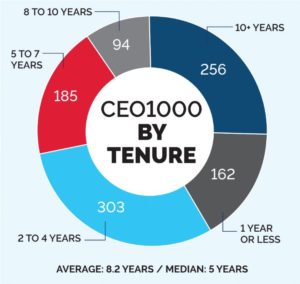 In 2016, Chief Executive Group and RHR International forged a partnership to launch the CEO 1000 Tracker. The partnership gathers, analyzes and reports information about the CEOs of the 1000 largest companies in America. This is the first of a new series of articles addressing the opportunities and challenges faced by CEOs over the five distinct phases in the Life Cycle of the CEO. Drawing upon targeted research and the decades of experience, Chief Executive Group and RHR International have in providing services to CEO and board audiences, the series will provide pragmatic insights to CEOs and their boards about navigating the challenges in each phase of their tenure.
In 2016, Chief Executive Group and RHR International forged a partnership to launch the CEO 1000 Tracker. The partnership gathers, analyzes and reports information about the CEOs of the 1000 largest companies in America. This is the first of a new series of articles addressing the opportunities and challenges faced by CEOs over the five distinct phases in the Life Cycle of the CEO. Drawing upon targeted research and the decades of experience, Chief Executive Group and RHR International have in providing services to CEO and board audiences, the series will provide pragmatic insights to CEOs and their boards about navigating the challenges in each phase of their tenure.
The Five Phases. While every organizational context is unique, there are some general imperatives that CEOs in each phase in the Life Cycle must address:
Preparation. Executives who aspire to a CEO role need to maximize their readiness to be viable candidates by tackling the following tasks:
Entry. The objective is to successfully integrate into the organization by meeting the following challenges:
Middle Phase. The challenges presented here will vary significantly depending upon the specific company context, but the overarching task is to drive the performance of the company. To do this, the CEO will need to:
Closing. The CEO prepares the next generation of organizational leadership and performance by:
Exit. The CEO cements his/her legacy by enabling an effective transition to his/her successor by:
Allowing the new CEO full latitude to lead without interference
The subsequent articles in this series will discuss practical ideas for how CEOs can effectively meet the challenges presented by each phase. Also, we’ll address what boards can do in each phase to maximize the CEO’s and the organization’s success.

Chief Executive Group exists to improve the performance of U.S. CEOs, senior executives and public-company directors, helping you grow your companies, build your communities and strengthen society. Learn more at chiefexecutivegroup.com.
0

1:00 - 5:00 pm
Over 70% of Executives Surveyed Agree: Many Strategic Planning Efforts Lack Systematic Approach Tips for Enhancing Your Strategic Planning Process
Executives expressed frustration with their current strategic planning process. Issues include:
Steve Rutan and Denise Harrison have put together an afternoon workshop that will provide the tools you need to address these concerns. They have worked with hundreds of executives to develop a systematic approach that will enable your team to make better decisions during strategic planning. Steve and Denise will walk you through exercises for prioritizing your lists and steps that will reset and reinvigorate your process. This will be a hands-on workshop that will enable you to think about your business as you use the tools that are being presented. If you are ready for a Strategic Planning tune-up, select this workshop in your registration form. The additional fee of $695 will be added to your total.

2:00 - 5:00 pm
Female leaders face the same issues all leaders do, but they often face additional challenges too. In this peer session, we will facilitate a discussion of best practices and how to overcome common barriers to help women leaders be more effective within and outside their organizations.
Limited space available.

10:30 - 5:00 pm
General’s Retreat at Hermitage Golf Course
Sponsored by UBS
General’s Retreat, built in 1986 with architect Gary Roger Baird, has been voted the “Best Golf Course in Nashville” and is a “must play” when visiting the Nashville, Tennessee area. With the beautiful setting along the Cumberland River, golfers of all capabilities will thoroughly enjoy the golf, scenery and hospitality.
The golf outing fee includes transportation to and from the hotel, greens/cart fees, use of practice facilities, and boxed lunch. The bus will leave the hotel at 10:30 am for a noon shotgun start and return to the hotel after the cocktail reception following the completion of the round.